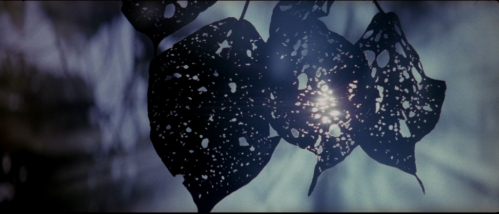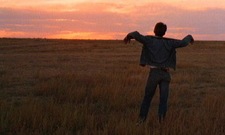After two acclaimed films in the 1970s, Terrence Malick fell off the Hollywood radar for two decades, moved to France, and lived the quiet life of a recluse. No one knew when or if he would ever make another film. But in 1998 he emerged with a third film, a big-budget WWII film (adapted from a James Jones novel) released the same year as Saving Private Ryan. It’s as if Malick wanted to hold the unresolved tension of his first two films as long as possible, waiting for just the right project to release the catharsis.
If The Thin Red Line is anything it is certainly a catharsis. The line between the holy and human is never as blurry within the Malick corpus as it is here. Even the form of the film, with its indistinguishable voiceovers and exchangeable characters, echoes this uncertain harmony. From the opening line of the film (“What’s this war in the heart of nature?”), the dualistic balancing act in nature takes center stage. While the protagonists of Malick’s two earlier films (Martin Sheen’s Kit and Richard Gere’s Bill) both encounter this “war” in nature, neither recognizes the simultaneous horror and rapture of existence for what it is. Only Line’s Witt (Jim Caviezel) sees the transcendental “light” amid the darkness all around him. Where others in that film succumb to desperation or nihilistic ambivalence, Witt sees sparks of a heavenly glory. He recognizes the seemingly paradoxical notion that “even—no, especially—in the throes of self-annihilation, man can apprehend the sublime,” as Gavin Smith wrote in his Film Comment analysis of the film.
The film’s World War II backdrop underscores the message of conflict as an elemental part of life, something running much deeper than just guns and bombers. It is a very Heideggerian notion—that reality shapes itself through conflict and struggle. As Heidegger puts it, the world (humanity) and earth (physical nature) are in a constant and essential striving, opponents that “raise each other into the self assertion of their natures” (“The Origin of the Work of Art”). Malick turns the philosophical concept into artistic exposition by showing how our existence is driven by conflicts between war and peace, darkness and light, love and strife, Paradise found and Paradise lost. It’s a film that is more interested in the fact that the world is governed by contrasts and conflicts, and less in the question of which side is right and which is wrong.
At the heart of the film is the notion that this warring tension is evidence of something other—some oneness and perfection just out of reach. It is perhaps what Chesterton deemed “divine discontent”—the happiness that comes from both loving and disdaining the world around us. If pure happiness is possible for man in this life, Chesterton says that it “will be an exact and perilous balance; like that of a desperate romance.” Happiness in life comes from the deepest longing for the other—for the filling of “the lack.” We see through the inhumanity of battle in Line that beyond the divisions of people and nations there is a common humanity that longs for that oneness and reconciliation which nature—in its beautiful brokenness—reflects.
As in all of his other films, Malick places his characters within gorgeous settings and idyllic landscapes, where they “move from innocence to experience haunted by a dream of Paradise” (Robert Silberman, “Terrence Malick, Landscape and ‘This War in the Heart of Nature'”). Indeed, the specter of Eden is ever present in his films–a haunting remembrance of some distant, more perfect world. In Line, the romantic longing is expressed in the film’s last monologue (which also foreshadows Malick’s 4th film, The New World): “Walked into the golden age. Stood on the shores of the new world.”
In Line, as in his other films, Malick uses raw and (relatively) unmediated nature as a chief expository tool. Much more than just a setting (the jungles of Guadalcanal) or a pretty background, the imagery in Line forms the heart of the film. Nature is at once cruel (creeping, suffocating vines) and beautiful (light filtering through the canopy), though in either case indifferent to human affairs. Like the final shot of an improbable palm sprout on the shores of a battle-weary beach, nature pushes on despite our best (or worst) intentions. The war in nature is eternal (at least as long as this world exists), and our own inner battles are indifferently digested in nature’s “neverthelessness.” Even so, there is a cleansing, redemptive power within in. Our transitory place within the realm of the physical brings us into an intimate bond with it. Water imagery in Line shows this, as does light. The baptismal quality of the former appears throughout—when Witt swims with the natives, when the soldiers swim during their leave, when the G.I. huddles in the cold, drenching rain, longing for purification. The divine illumination of the latter also offers redemption—lighting our dark hearts, warming our cold souls, and keeping the “spark” alive.
If nature is the heart of this film, then the character of Witt is its soul. Witt sees the spark in others, even when they don’t see it in themselves (as in Sean Penn’s character). Witt looks into the eyes of the dying, and where others might see depravity and waste, Witt sees the glory. What Witt sees in his comrades and enemies is less the ‘heart of darkness’ than the ‘heart of the ordinary’—ordinary men bound by the thin red line which encircles them as they walk the threshold between life and death, in the fragile, liminal space between meaning and meaninglessness.
Witt approaches death with startling metaphysical calm. He begins the movie skeptically, musing about his mother’s death: “I was afraid to touch the death that I see in her. I couldn’t find anything beautiful or uplifting about her going back to God. I heard people talk about immortality, but I ain’t never seen it.” Over the course of the film, however, Witt comes to realize that mortality and immortality are symbiotic rivals, at war and peace with each other like most else in nature.
At the beginning of the film Witt explains his longing to meet death in the same way as his mother (“with the same calm”), because “that’s where it’s hidden—the immortality that I hadn’t seen.” When death comes knocking, Witt faces it with similar peace, looking upwards at the light as it ushers him out of time. His selfless action–leading the enemy away from his company and offering himself as a sacrifice so that others might live–is a fitting culmination of the film’s redemptive momentum.
Witt comes to a peace about an unsettling question that defines the film’s existential pondering (and is expressed in the closing monologue): “The darkness and the light, are they the workings of the same face?” Sure, it’s true that “nature’s cruel” (one of Nick Nolte’s best lines in the film). But Witt sees that even in spite of the cruelty of nature, beauty and grace prevail: “All things shining.”
Even in the hardened face of the character (Sean Penn) who seems resigned to the “survival of the fittest” way of nature, Witt is able to recognize the way of grace: “I still see a spark in you.”
It’s this sort of interplay between nature and grace, security and passion, survival and sacrifice, that has always interested Malick. It’s a heavenly light glimmering through deteriorating leaves in the canopy, an alligator swimming freely and an alligator bound (two images in Line), aggressive waves crashing against a passive shore. It’s beauty through dynamics. The harmonious consonance of seemingly conflicting, dissonant things.




 ;
;





















To Brett McCracken:
I’m about to see Line again, on a big screen with good sound (Malick revival here in Chicago at Music Box theatre, in preparation for The Tree of Life), and it will be my fourth experience of this, the most glorious and perhaps the greatest of all movies. (See it only on the big screen!) Your essay is a godsend, capturing the themes, the dialectic of oppositions, the visual sublimity, all working together; only the essay by Leo Bersani and Kaja Silverman competes with yours, of those I”ve read. The one thing to be added is the score–Zimmer’s music captures the sense of glory and of near-aybsmally beuaitful loss like no other film score I can think of. The lump in my throat every time I see this, from the first image and first chord, and which lasts for the movie’s nearly 3 hours, is sparked by Malicks understanding of transcendence, but also by the music that enfolds us. Thank you for putting Malick in the center, where he belongs (or should I say, thanks for putting him in the canopy, where the light shines).
Regards,
Douglas Mitchell
Executive Editor
University of Chicago Press
Thanks Douglas! Really appreciate the comments & glad you liked the essay. Glad to hear the Music Box is doing a revival- it’s been so nice to see the films again on the big screen in L.A. at LACMA’s retrospective.
And I definitely agree about Zimmer’s score… it’s up there on the list of my favorite scores of all time. I too get a lump in my throat each time I watch the film. Such a beautiful, transcendent masterpiece.
Pingback: May is Terrence Malick Month | The Search
Pingback: 39 Facts About Terrence Malick | The Search
I love movies …but can only watch, even my favourite ones, only once or twice usually. I’ve seen “Line” over 30 times now – I’m glad to hear someone else shares my opinion that it’s the greatest film ever made.
Pingback: Advent & Malick | The Search